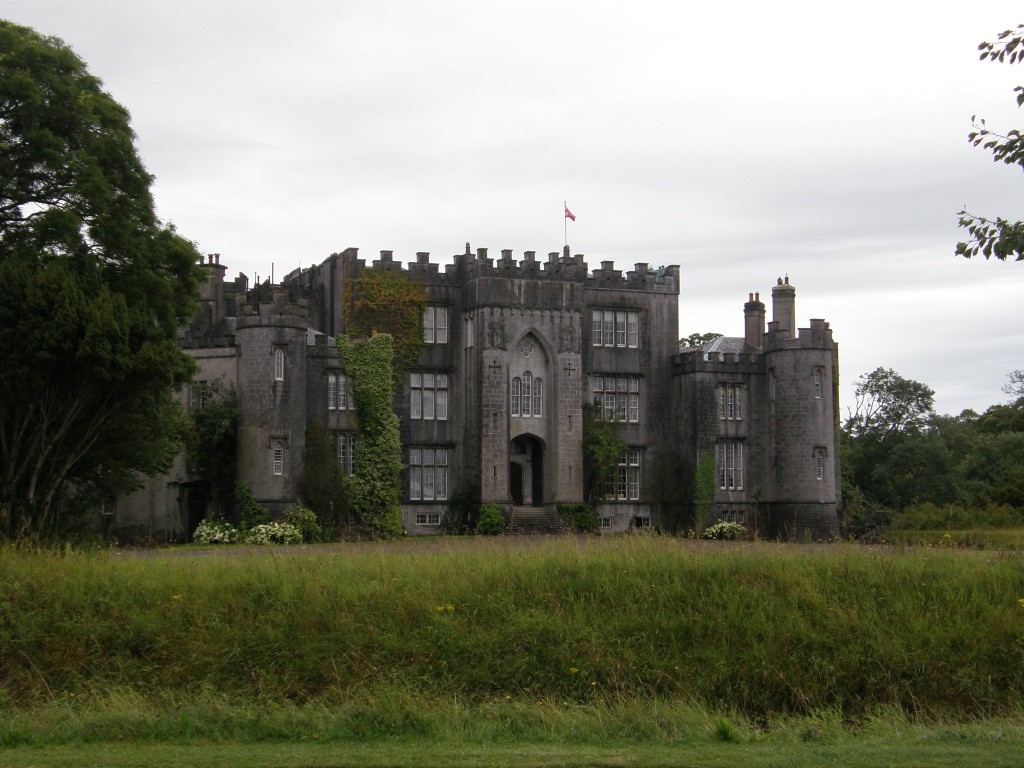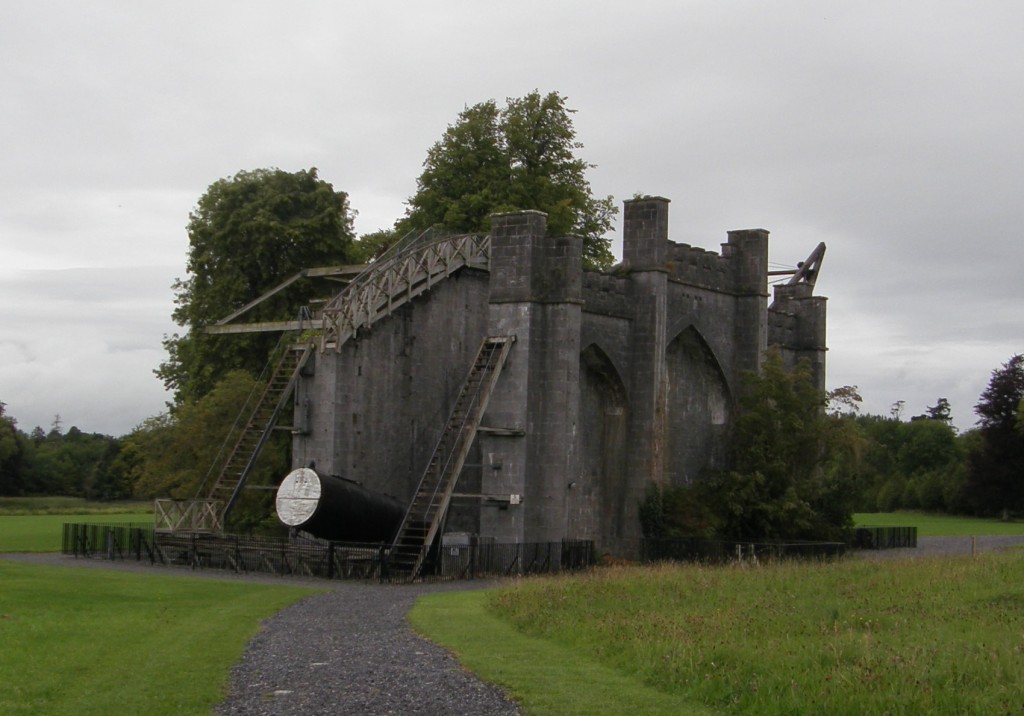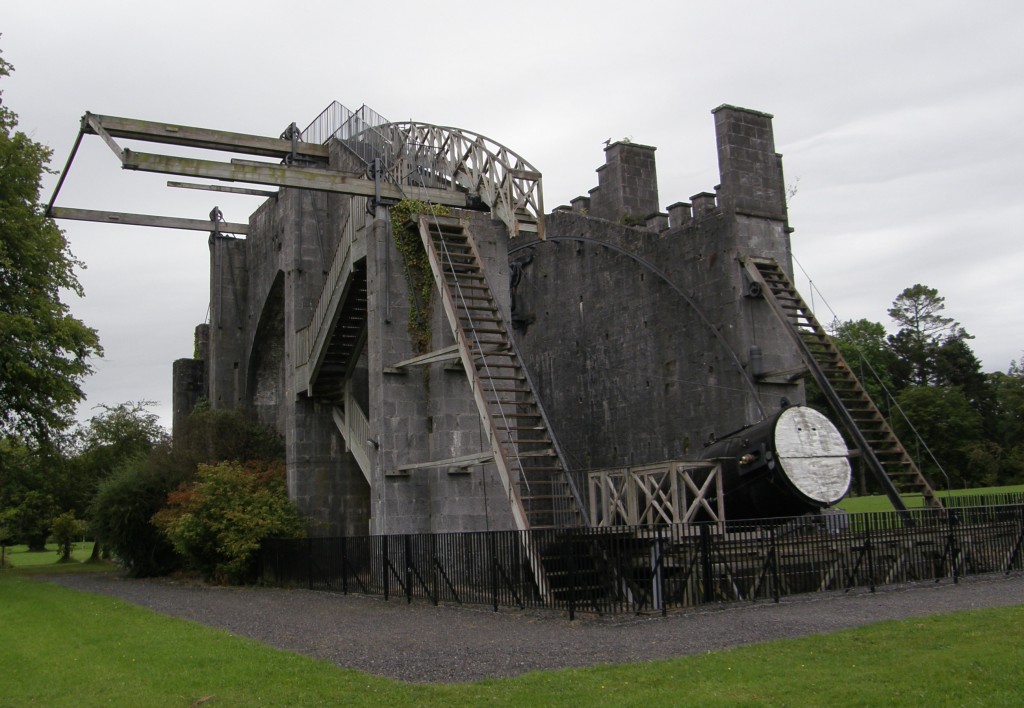I left An Cheathrú Rua on Friday, August 12, 2011, and drove (by back roads, not on the motorway) to Beannchar na Sionna, Contae Uibh Fhaili (Banagher, County Offaly – the Irish name of the town, from the words beanna meaning “antlers” and carraig meaning “rock”, means “place of pointed rocks on the Shannon River” – the county name comes from that of an ancient Irish kingdom, the Uí Failghe). I will be renting a cottage there for a month beginning in a few days and wanted to stop at the cottage to drop some things off with the landlords before continuing to Contae Chill Mhantáin (County Wicklow) where I am visiting the following locations:
Glendalough, site of St. Kevin’s Monastery.
Wickow Town, port city and site of an historic gaol (“jail” to Americans)
Avoca, the town where the BBC series Ballykissangel was filmed
Leaving Banagher, I found myself driving through the city of Birr directly beside Castle Birr and decided, “What the heck? I have time. I’ll visit the demesne of Castle Birr.” Castle Birr is the historic home of the Earls of Rosse and is still occupied by the Parsons family today. Thus the castle itself is not open to the public, but the grounds are.
There has been a castle on the site since 1170. From the 14th to the 17th centuries the Ó Céarbhaill family of Eile (Anglicized: O’Carroll of Ely) ruled this part of Ireland. (Their northen neighbors were the Ó Conchubhair Failghe, from which the county gets its name.) The O’Carroll’s ruled from a castle called “The Black Tower” which no longer exists.
After the death of Sir Charles O’Carroll, Sir Laurence Parsons was granted Birr Castle and 1,277 acres of land in 1620. He engaged English masons in the construction of a new castle making use of the gatehouse of the old Black Tower as its foundation. Flankers were added to the gatehouse diagonally at either side, giving the castle the plan it still has today. Descendants embellished the castle in the 18th century and by 1840 it looked as it now does. It is a 100-room private home!
The third Earl of Rosse, William Parsons, had no interest in adding to the castle. Instead, his interest lay in astronomy, particularly the study of nebulae, and he took it upon himself to build the largest telescope yet constructed. In 1845 he built on the castle grounds the “Great Telescope”, also called “the Leviathan of Parsonstown”, a reflecting telescope with a 72 in aperture. It was the largest telescope in the world until the Hooker Telescope was built at Mt. Wilson Observatory in California in 1917.
Parsons did not use the telescope for nearly three years after its construction because he turned his attention to famine relief (these were the years of the Great Hunger). But in 1847 he began his work, cataloging and studying nebulae. He discovered 226 of the nebulae and other deep sky objects eventually listed in the New General Catalog compiled in the 1880s by J. L. E. Dreyer and published by the Royal Astronomical Society in 1888.
After his death in 1867, his descendants used the Leviathan for another forty or so years. However, it fell into disuse and was partially dismantled in 1908; in 1914, one of the mirrors with its mirror box was transferred to the Science Museum in London. The walls remained. The tube, second mirror box, and universal joint survived. Eventually, however, even these were removed for safety reasons.
In the 1990s, the Leviathan was restored. Since there were no surviving plans, the restorers worked from Parsons’ notes, descriptions written by visitors, drawings and photographs. The restored instrument is what one now sees on the demesne of Birr Castle.
The Leviathan and the work of the various members of the Parsons family in astronomy and other sciences are the reason there is a pretty good “history of science” museum on the castle grounds. As I read about George Johnstone Stoney, one of William Parsons’ assistants who went on the achieve his own sort of fame as a physicist and the originator of the term electron, I thought this post about Castle Birr would be a good place to throw in some thoughts I’ve been having about string theory and God.
While on this trip, I’ve been reading The Elegant Universe by Brian Greene (Vintage Books 2000). I mentioned in another post that, for some reason, my “recreational reading” these days seems to be in the area of quantum mechanics and string theory…. I think this is because I am fascinated by the echoes of spirituality, theology, and religion I find in the comments of the mathematicians and physicists who write in this area for the general public. For example, about halfway into this book, Greene writes:
Imagine a universe in which the laws of physics are as ephemeral as the tastes of fashion – changing from year to year, from week to week, or even from moment to moment. In such a world, assuming that the changes do not disrupt basic life processes, you would never experience a dull moment, to say the least. The simplest acts would be an adventure, since random variations would prevent you or anyone else from using past experience to predict anything about future outcomes.
Such a universe is a physicist’s nightmare. Physicists – and most everyone else as well – rely crucially upon the stability of the universe. The laws that are true today were true yesterday and will still be true tomorrow (even if we have not been clever enough to have figure them all out). (Pp 167-68)
That sounds an awful lot like something in Holy Scripture – this bit from the Letter to the Hebrews: ” Jesus Christ is the same yesterday and today and forever.” (Heb. 13:8, NRSV) Greene may have been intentionally echoing Hebrews, but I don’t think so. I think the scientific quest for “the theory of everything” springs from the same source as the religious quest for understanding, and that both science and religion seek the stability of that which is, always has been, and always will be true. Later in the book, Greene discusses the application of string theory to cosmology and the ways in which the two fields learn from each other:
[T]he study of cosmology does hold the promise of giving us our most complete understanding of the arena of the why – the birth of the universe – and this at least allows for a scientifically informed view of the frame within which the questions are asked. Sometime attaining the deepest familiarity is our best substitute for actually having the answer. (Pp. 364-65)
I’m taken by that last thought, that “deep familiarity” is a substitute for “an answer”; I might even amend Greene’s thought to suggest that “deep familiarity” is the answer. Throughout the book Greene refers to spacetime as “the fabric” of the universe. For example, close to his conclusion he writes about the question of whether there was something “before” time, “before” space:
[D]escribing the spacetime fabric in [a] string-stitched form does lead us to contemplate the following question. An ordinary piece of fabric is the end product of someone having carefully woven together individual threads, the raw material of common textiles. Similarly, we can ask ourselves whether there is a raw precursor to the fabric of spacetime – a configuration of strings of the cosmic fabric in which they have not yet coalesced into the organized form that we recognize as spacetime. (P. 378)
The Hebrew Scriptures also speak of deep familiarity and use similar metaphors in describing God’s creative action, the metaphor of knitting and weaving. Jeremiah the prophet, for example, records his call to ministry quoting God as saying to him, “Before I formed you in the womb I knew you, and before you were born I consecrated you,” (Jer. 1:5) words that I recalled when I read Greene’s passage above about the “raw precursor” before the universe had “coalesced into the organized form that we recognize as spacetime.” In Psalm 139 themes one finds in Greene’s book, light and dark, weaving and pre-existence, are found together in a religious expression of the same yearning for deep familiarity:
If I say, “Surely the darkness will cover me, *
and the light around me turn to night,”
Darkness is not dark to you; the night is as bright as the day; *
darkness and light to you are both alike.
For you yourself created my inmost parts; *
you knit me together in my mother’s womb.
I will thank you because I am marvelously made; *
your works are wonderful, and I know it well.
My body was not hidden from you, *
while I was being made in secret and woven in the depths of the earth.
(Psalm 139:10-14 From the American Episcopal Book of Common Prayer Psalter)
In Greene’s discussion of that “raw precursor” before time and space, I was also reminded of the theological terns chronos and kairos, two different understandings of time which come into Christian theology through Greek philosophy. The first, chronos, is time on the move, time with a before and after, time in which we look to the future, experience the present, and remember the past. This is the time Greene writes about when he says, “[W]e, our friends, our belongings, and so forth all move through time … time [is] another dimension of the universe – the fourth dimension.” (p 49) Chronos is measurable, dimensional time.
The second Greek word for time is kairos, which considers time as qualitative rather than quantitative, as significant rather than dimensional; it speaks of time as a moment, time as occasion. Theologically, kairos refers to the “eternal now”, to God’s time, to time outside of time, to the eternal as distinguished from the everlasting. In kairos, there is no sequence, no before and after, no dimensionality, no length to it at all.
Not quite at the conclusion of this book, Greene says:
The astonishment at our ability to understand the universe at all is easily lost sight of in an age of rapid and impressive progress. However, maybe there is a limit to comprehensibility. Maybe we have to accept that after reaching the deepest possible level of understanding science can offer, there will nevertheless be aspects of the universe that remain unexplained. Maybe we will have to accept that certain features of the universe are the way they are because of happenstance, accident, or divine choice. (P. 385)
Reading those words and Greene’s conclusion two pages later, in which he encourages us all to keep striving for answers, to keep seeking to comprehend, I thought how often we have heard scientists, particularly physicists, compared to children playing with fire, and that reminded me of a Scriptural answer to Greene’s “maybe” … that there will be a time when our childish “maybes” will be resolved:
For now we see in a mirror, dimly, but then we will see face to face. Now I know only in part; then I will know fully, even as I have been fully known. And now faith, hope, and love abide, these three; and the greatest of these is love. (1 Cor. 13:12-13, NRSV)
The Leviathan of Parsonstown is a monument to that seeking spirit which informs both science and religion, that searching for comprehension that will be answered in the “eternal now” by that “raw precursor” Who was before time and space.








OK Eric, it must be too late for me to comprehend, so I will read what you have shared, again tomorrow. It’s too interesting to not re-read. Love the photos however.
I fondly recall many visits to the Mt. Wilson Obervatory when the family lived in San Diego.
Don’t worry about understanding the physics and the string theory, Kim. I don’t understand it, I just read about it.
Eric–The Earls of Rosse have a long association with the diocese of Ohio They were among the early supporters–at least the Countess was–of Kenyon College. Hence, Rosse Hall on the campus. The Earl of Rosse visited the campus in the late 80s, early 90s.
Let’s talk sometime about the significance of the Earl and his great telescope in the scientific controversies of the 19th century.